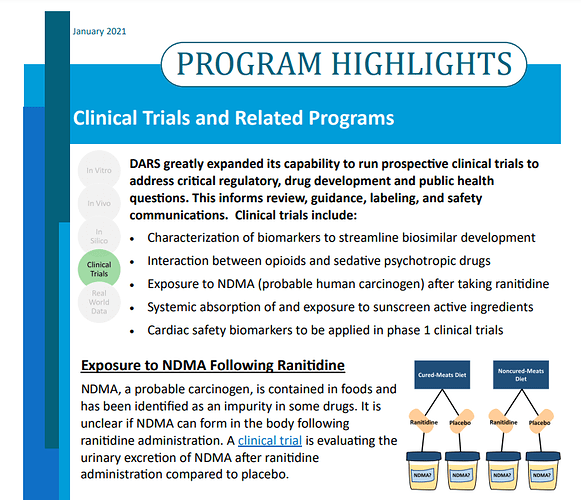Today FDA’s Division of Applied Regulatory Science published their 2020 annual report. Nitrosamine did not escape the report… ‘Exposure to NDMA following Ranitidine’
Report download here: https://www.fda.gov/media/147239/download
Interesting and very relevant retraction… It looks like it’s due to potential artefacts from the GC experiment resulting in increased levels of NDMA being reported than were actually present in the samples.
- June 28, 2021 FDA paper on the Effect of Oral Ranitidine on Urinary Excretion of N -Nitrosodimethylamine (NDMA)
[Effect of Oral Ranitidine on Urinary Excretion of N-Nitrosodimethylamine (NDMA)]
In this crossover, randomized clinical trial that included 18 healthy participants, oral ranitidine (300 mg), compared with placebo, did not significantly increase 24-hour urinary excretion of NDMA when administered with a noncured-meats diet or a cured-meats diet (median of the paired differences, 0 [interquartile range, −6.9 to 0] ng and −1.1 [interquartile range, −9.1 to 11.5] ng, respectively).
The findings do not support that ranitidine is converted to NDMA in a general, healthy population.
- June 28, 2021 FDA paper on the In Vitro Analysis of N -Nitrosodimethylamine (NDMA) Formation From Ranitidine Under Simulated Gastrointestinal Conditions
[NDMA Formation From Ranitidine Under Simulated Gastrointestinal Conditions]
In this in vitro study of 150-mg ranitidine tablets added to simulated gastric fluid, NDMA did not form when gastric nitrite concentrations were at the upper range of physiologic or at nitrite concentrations as much as 50-fold greater than the upper range.
In this study, 150-mg ranitidine tablets did not convert to NDMA in simulated gastric fluid with physiologic nitrite concentrations.
- July 2, 2021 FDA press release on the papers
See this interesting paper by Teasdale on Regulatory Highlights which discusses the root causes of NMDA formation from ranitidine.
@kpcross @AndyTeasdale recent regulatory highlight has been very well received by the community. Several discussion threads related to topics raised there.
The Ranitidine worked referenced Searle et all demonstrated that NDMA is formed because of an intermolecular degradation reaction in solid-state. What is fascinating to me is the link between NDMA rate of formation and the crystal morphology, with columnar crystals exhibiting the slowest rate of formation.
Naiffer, the link you provided to the toxplanet CPDB web-site does provide TD50 values, a study data summary, and literature references to their carc studies. And yes this is a static database. The FDA has determined that the CPDB carc studies for NMPA were not robust enough so that a rat TD50 value could be used. Consequently, they defaulted to the TD50 value for NDEA. NDMA is the most widely studied nitrosamine. The Nitrosamine SAR workgroup is developing monographs for NDMA as well as other popular nitrosamines. Hopefully, these will be published later this year.
